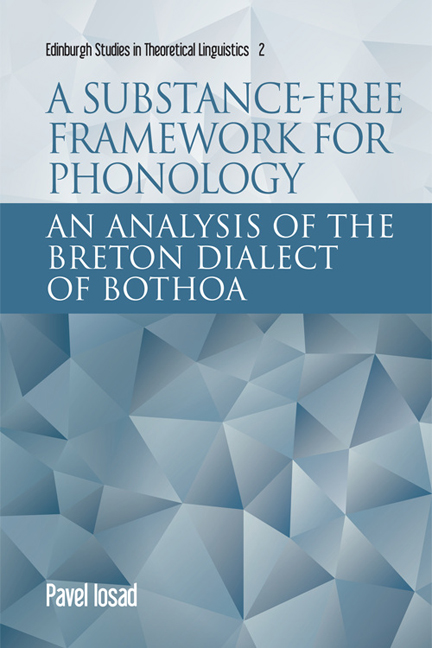Book contents
- Frontmatter
- Contents
- Acknowledgements
- Chapter 1 Introduction
- Chapter 2 Conceptual foundations of substance-free phonology
- Chapter 3 Representational assumptions
- Chapter 4 Computational assumptions
- Chapter 5 Complexity and markedness in substance-free phonology
- Chapter 6 The Breton language
- Chapter 7 Segments and representations
- Chapter 8 Suprasegmental phonology
- Chapter 9 The phonology of vowels
- Chapter 10 The phonology of consonants: palatalisation and gliding
- Chapter 11 Laryngeal phonology
- Chapter 12 Conclusion
- References
- Index
Chapter 6 - The Breton language
Published online by Cambridge University Press: 20 December 2017
- Frontmatter
- Contents
- Acknowledgements
- Chapter 1 Introduction
- Chapter 2 Conceptual foundations of substance-free phonology
- Chapter 3 Representational assumptions
- Chapter 4 Computational assumptions
- Chapter 5 Complexity and markedness in substance-free phonology
- Chapter 6 The Breton language
- Chapter 7 Segments and representations
- Chapter 8 Suprasegmental phonology
- Chapter 9 The phonology of vowels
- Chapter 10 The phonology of consonants: palatalisation and gliding
- Chapter 11 Laryngeal phonology
- Chapter 12 Conclusion
- References
- Index
Summary
The Breton language belongs to the Brythonic subdivision of the Celtic group of the Indo-European language family. It is spoken in Brittany, a peninsula in the west of present-day France, where it was brought by settlers from Britain in the fifth century ad. Historically, it has been spoken in Lower Brittany (French Basse-Bretagne; Breton Breizh-Isel), i.e. in the western part of the historic Duchy of Brittany. Today, native speakers are mostly spread throughout rural Brittany, and the language is severely endangered.1
Dialectal divisions
Traditionally, Breton is divided into four major dialect groups, on the basis of the old diocesan borders. These are as follows:
• Cornouaillais (Kerneveg), the dialect of Cornouaille, the biggest of the dioceses covering the south-west corner of Lower Brittany and most of its inland region. The traditional centre of the diocese is the city of Quimper (Kemper); today it covers the southern part of the département of Finistere (Penn-ar-Bed), and also includes some regions in the south of the département of Côtes d'Armor (Aodoù-an-Arvor) and in the north-west of Morbihan (Mor-Bihan).
• Léonais (Leoneg) is the dialect of Léon, the diocese in the north-west of Brittany centred around Saint-Pol-de-Léon (Kastell-Paol); today the northern part of Finistere.
• Trégorrois (Tregereg), in the north-east of Brittany, and in today's département of Côtes-d'Armor. This also includes the dialects of Goëlo, a small area in the extreme north-east of the Breton-speaking region, which belongs to the otherwise entirely Romance-speaking traditional diocese of Saint Brieuc (Sant-Brieg).
• Vannetais (Gwenedeg), spoken in the south-eastern part of Brittany, in the traditional diocese of Vannes (Gwened).
It is often claimed in the literature that the first three dialects are relatively homogeneous, and they are sometimes referred to together as a single dialect grouping called KLT, which is opposed to the Vannetais dialect. The basis for this division is partly philological and partly sociolinguistic. Philologically, Vannetais presents striking differences with respect to the other dialects. Most prominently, it has final stress where other Brythonic varieties show penultimate stress (although it is not universally agreed whether this is a shared innovation or a retention); on the other hand, Vannetais dialects show the sound change of proto- Brythonic *θ to [h]. From a sociolinguistic perspective, Vannetais has had a literary tradition separate from the other Breton dialects (Guillevic and Le Goff 1902).
- Type
- Chapter
- Information
- A Substance-free Framework for PhonologyAn Analysis of the Breton Dialect of Bothoa, pp. 67 - 73Publisher: Edinburgh University PressPrint publication year: 2017



